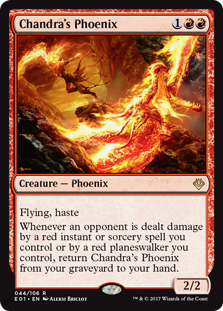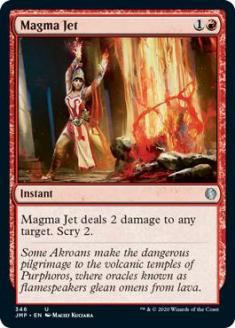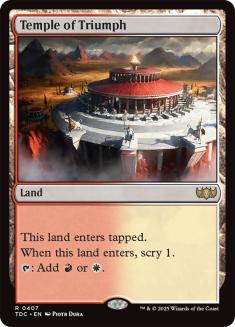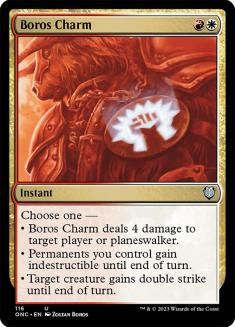I had to do a lot of soul searching for the SCG Invitational in Charlotte. As I alluded to in my article last week, I was in a major slump, I couldn’t figure out where my place was in Standard, my Legacy deck felt like it couldn’t buy a game, and I was playing extremely poorly lately. I almost considered not playing because of how much my confidence was waning. Then I decided to take some much needed time to figure out what I wanted out of the tournament. I jotted a bunch of things down—I wanted to win, I wanted the glory, I wanted to play in the SCG Players’ Championship. It was then that I realized just how stupid I was for having those be the first reasons I put down.
Whenever I have played my best, I was also having the time of my life. I was just playing Magic, without a care in the world and without pressuring myself to do well. I had to go back to that—back to doing whatever I wanted and playing the game on my own terms.
So I told myself not to have expectations going in. Learning and just getting better was what got me here in the first place, so I reset my mindset to just that. Winning is a side effect of improving, and making improving a priority helps streamline everything else.
It was my birthday, after all, and this was my weekend to celebrate and have a good time.
My mission to defeat Esper Control was still ongoing, and I was becoming more confident in accomplishing that goal as the week went on. With Esper’s unreal performance the weekend before at both Grand Prix Cincinnati and the Open Series in Los Angeles, I knew I had to ask myself what the Esper decks were going to do to beat the other Esper decks as well.
I tried as hard as I could to keep track of the information going around the Internet on social media and in articles throughout the week. I must have gone through Gatherer upward of ten times a day, trying to find any bit of edge that Esper players would use for the mirror. I played Esper mirrors myself to get the hang of what they were generally trying to do. I even went to the StarCityGames.com sales booth before the event to find out what was selling and what was trending. Then I used all of that information against them.
I was obsessed, but I loved it:
Creatures (8)
Lands (15)
Spells (37)

Every hour that I studied, I felt more comfortable and confident about where I wanted to be in round 5. I was getting into the preparation rhythm that I tend to get in when I’m feeling good about an event. I was figuring out why Esper Control was the best deck in the format, and I was figuring out why others couldn’t consistently take it down. We were using outdated technology and weren’t really adapting fast enough. We kept slamming head first into Blind Obedience; Thoughtseize; and Elspeth, Sun’s Champion like there was nothing we could do. Fiendslayer Paladin was a major concern, and I did what I could to keep that piece of information to myself (it’s a good thing no one asked me about it!).
When building this deck, I knew that I wasn’t interested in having a bunch of small creatures against Esper Control out of the board because of Blind Obedience and Fiendslayer Paladin, so Viashino Firstblade, Firedrinker Satyr, and the like were ruled out. Ash Zealot eventually got cut as well since Josh Silvestri blew my mind with his wealth of knowledge.
You’re kind of pigeonholed into playing crappy Boros Guildgates in the original build because of how intensive your red is. This is the same reason why you really can’t afford to play more than four Temples, especially if they’re off color. This creates a lot of tension with your white sources, which carries over to your Chained to the Rocks. Josh figured out that Ash Zealot was the primary reason for this awkward natured ripple effect and suggested Young Pyromancer in its place.
Searing Blood also contributes to this, but it doesn’t get outclassed nearly as badly as Ash Zealot after turn 2 unless you’re facing Pack Rat. In theory, this would allow me to play as many Temples as I wanted, meaning I’d have more white sources in Temple of Silence, improve my game against Desecration Demon, move Chained to the Rocks to the sideboard since I can chump block Monsters at will, and have a midgame plan for the mirror and Mono-Blue Devotion.
I was instantly sold.
From there everything came together, and what felt like a forced build before turned into a great amount of freedom and control over most of the shell.
Then I worked on getting the rest of the numbers where I wanted them to be.
Temples: I felt that I could afford to play up to eight Temples, but I wasn’t sure how many off-color ones I could afford. Two copies of Temple of Silence felt right, but it’s close.
Note that if you aren’t playing any Toil // Trouble, you can use Temple of Enlightenment instead of Temple of Silence as a way to gain an edge against players. They can potentially put you on U/W Control in the first turn of the game, altering their decision tree. It’s a very minor edge, but you want to take what you can get at this level.
Zero maindeck Chained to the Rocks: As said above, Chained to the Rocks isn’t as necessary as before due to Young Pyromancer providing a steady stream of chump blockers. I didn’t expect to see as much Mono-Blue Devotion because everyone was overselling how bad of an Esper Control matchup it has (which I think is greatly exaggerated). This gave me a couple of spots to add some additional burn and further have my Temples translate into more damage.
2 Toil // Trouble: I don’t really think there’s a better burn spell after the core, so having the off chance of doming your opponent for five or more is worth the three mana. While you don’t have that many black sources, you will sometimes be given the option of simply casting Toil or possibly fusing them out. This spot could have also been Spark Trooper, as I didn’t think I’d run into any maindeck copies of Blind Obedience and it’s also really good at tackling a Jace, Architect of Thought to free up your Elemental tokens. I’m still debating if I want a fifth four-drop at sorcery speed, however, since it opens me up pretty badly to countermagic and other instant speed removal and is really bad against Mono-Black Devotion and its variants.
4 Magma Jet: This is the most important card in your deck. Do not even think about playing fewer than four of these. I’m of the firm belief that while scrying is probably at its best in control decks, it can directly dictate the fate of the game in R/W/B Burn. You really can’t afford to draw cards that don’t translate into damage, but you also need to hit land drops at the correct time, especially white sources. Magma Jet acts as a bridge for both of those issues while also advancing you toward your goal.
The Sideboard
When building the sideboard, I (along with everyone I talked to) thought that sideboarding into haste creatures was definitely not where we should be. Between Blind Obedience and Fiendslayer Paladin, cards like Viashino Firstblade and Spark Trooper were not great options even in the mirror, where even they’re starting to pick up on Blind Obedience as well.
Glare of Heresy seemed like the best overall heads-up answer to the two major problem cards as well as Unflinching Courage; Detention Sphere; Brimaz, King of Oreskos; and Boros Reckoner. I strongly debated the third one, but I didn’t know what to cut. Fated Conflagration is a potential cut, but I’m a huge fan of how many problems it covers. If the trend of Fiendslayer Paladin doesn’t pick up, then I’ll stick with Blind Obedience.
With those things said, I wasn’t really planning on bringing in the red Hero’s Downfall against major cards like Polukranos, World Eater. Why? Because I couldn’t find more cuts outside of Shock, Toil // Trouble, and Skullcrack. It’s possible that some number of Young Pyromancer or even Lightning Strike can go, but as of this writing, I’m not very comfortable with that. The value of the card does go down quite a bit if I’m not bringing it in against Monsters, but scry 2 is once again the key that makes it more effective than something like Mizzium Mortars despite the difference in mana.
There’s a similar story with Spark Trooper. If I’m not bringing it in against decks like burn and control, where do I want it? Well, Spark Trooper is one of the ways you can catch up with Monsters decks on the draw when Stormbreath Dragon isn’t part of the equation, especially Jund Monsters. I also wanted additional slingshot effects against Mono-Blue Devotion and white-based aggro.
Boros Reckoner and Chained to the Rocks are for really large creatures, with Chains having applications against Mono-Blue and Mono-Black Devotion and Reckoner also being effective against burn decks as both an effective beater and a way to block Spark Trooper profitably. The Reckoner and I go way back, and it has never let me down before, so I knew the combat-savvy Minotaur would have my back this time around as well.
Lastly, there’s Burning Earth. I was banking really hard on Burning Earth for this event, and I was torn between playing a third or not. I don’t even really know how good it is against Esper Control by itself, but I know for a fact that I can get away with jamming as hard as I can when I have Glare of Heresy to trade for their extremely valuable Detention Spheres.
Decision Trees With Scrying
This can be an incredibly difficult process when going about a game, as every single card you draw is so crucial. There will be times when you scry and make a decision that appears to go against what you need at that point in time, and in this particular build it’s even more important since you’ll be scrying a lot more than most.
Let’s take a look at an opening hand example to better explain what I mean by this.
What do you plan on doing in the first three turns of the game on the play and why? What about on the draw? Let’s look at a few of my thought processes.
One line I can see is playing a Mountain on turn 1 and passing. The reason for this is because to the extent of my scrying knowledge, I’m not entirely sure what I want yet. Yes, I know that any burn spell is probably fine, but we don’t know which burn spell yet. Skullcrack is obviously insane against Esper Control, but what happens if we hit Searing Blood? How do we know if we’re ever going to get to cast that card? What if we hit Warleader’s Helix?
The second line I can see making is to play Temple of Triumph on turn 1, hoping to hit a land. If we go this route, what happens if we Magma Jet into a fourth land that doesn’t produce white mana?
That about does it for the strategy side of things, but I want to talk about a recent discussion that I aggressively and perhaps rudely brought up on Twitter last week, which involved me being tired of the stigmas that come with players and their deck choices. It was met with a lot of constructive debate, and I was very appreciative of how much reception it received.
To put it simply, I want to end the stereotypes surrounding players and their archetype preferences.
I think that red decks and burn decks in general have a very bad reputation for being "easy," "for little kids," or "dummy proof." There seems to be these emotional attachments when a player casts a turn 1 Firedrinker Satyr or end step Shock. The "oh, he’s playing Mono-Red Aggro, so he must be bad" type of thing. We have this ongoing trend of trivializing these strategies, with one reason being because of this superiority complex that so many seem to have. I’ve even heard on multiple occasions at Open Series and Grand Prix that players specifically choose control decks because they want to show off their intelligence to other players.
I think all of those claims are ridiculously absurd, particularly in Standard right now.
I am by no means trying to say that one deck is harder or easier than another, but I am saying that the skill level of a deck isn’t necessarily reflective of the skill of a player.
We are in the most difficult Standard format in a very long time, and almost every deck is a major challenge to play well. Why are we so emotionally invested in what other players play or how they play? Why are we not more strategically invested? Last time I checked, those that want to succeed in major events will play what they legitimately feel gives them the best chance to win the tournament or will play what they’re most comfortable with (and the two aren’t mutually exclusive). Who are we to judge others for that?
I won’t argue that some decks test different skills than others. A Zoo deck most likely won’t test the same skills as a combo deck, and each game of Magic that doesn’t involve busted nut draws (and even some that do) will be different, likely testing different skills as well.
But I will argue that you aren’t really doing anyone any favors by overestimating or trivializing other players because of what they happen to be playing. If you’re putting that much effort into being that closed minded toward decks and players, then chances are you can work more on your own development as a player.
Here’s a rather blanket question to give some perspective. If we consider Patrick Sullivan one of the best red mages in the world and consider someone else one of the best blue players in the world and they have the same accomplishments as Patrick, would you consider Patrick’s accomplishments less noteworthy? Red is a worse color than blue, and blue requires more skill than red, right? Why would you discount someone’s accomplishments based on what they battled with to get to those accomplishments?
I know this has turned into a bit of a ramble, but it’s a serious problem that I really want to bring attention to. How do we fix this problem? I don’t know, but I do know that in a general sense we need to do a better job of not forcing our qualities and opinions as players on to others who may not share those qualities and opinions. Just because you 4-0ed your FNM with a burn deck two weeks in a row doesn’t mean that the deck is "easy", and it certainly doesn’t mean that it requires no skill.
Instead of being so judgmental toward others, I think we should work more toward encouraging players to maximize the choices that they do make. If someone wants to play a control deck, I’m not going to tell them "but Sphinx’s Revelation isn’t a skill-intensive card" regardless of how much I may or may not think that’s true.
Phillip Bertorelli really brought light to this issue in The Industry Standard article he wrote after winning the SCG Standard Open in Worcester back in October:
"Playing a red deck can be as simple or as complicated as the pilot wants to make it, just like any other deck in Magic. A solid red mage will and should always approach a control matchup not by focusing on their own hand but instead with the intent to act as a puppeteer forcing the control player to play their cards in a particular order and fashion, picking up on subtle queues and the causal factors that encourage a control player to respond with a particular card or play. Deduction is one of the red mage’s most powerful tools, and even a minor miscalculation between when to bait and when to mount an all-out offensive is often the difference in the matchup. In essence, both players are in some ways playing the blue deck jointly.
If you think about it objectively, this is very similar to a blue mage, who also tries to coerce but instead of doing so by applying pressure through various angles like a red deck does so by deceptive inaction at times. Each is equally complicated, searching for tells and hints through the ordering of spells and toying with decoys to get possible reads. Neither is more or less skill intensive than the other from simply a color standpoint. Is it honestly more difficult to know when to counter a spell versus when and where to use direct damage?
These decisions each have subsequent ripple effects from that point forward that impact the course of a game, and each requires careful consideration. I would argue that both are very complicated in their own right when not cornered. To elaborate, in times of desperation both decks become much more predictable as they’re clutching to avoid losing control of the matchup, and it’s at that point that the games are typically won or lost. I want to emphasize that these thoughts are in no way intended to knock particular colors or archetypes but are instead to shed a more positive light on perceived simple red decks. Obviously, this is not a complete blanket statement as well.
Some red decks truly are built to be simple, just as green or white decks may be as well, so this logic must be regarded in the appropriate context. But it’s just that—each deck must be viewed independently based on the cards and relationships that comprise them rather than holistically by the colors that comprise them. The message is simply to reinforce the fact that you can’t judge the difficulty of a deck simply by its color and that you must instead thoroughly investigate its contents before making a determination either way.
So what typically makes a deck more complicated than another if not the mana symbols? In my opinion, on the most granular level the answer quite simply is how many decision points are generated from each card and each relationship among the cards within your deck on an individual and collective level. This is proportionate to the number of different choices each individual card elicits independently, the total number of synergies throughout a deck’s entire composition, and the possible interactions with opponents causing them to continually reevaluate their decision making processes since their decisions ultimately impact yours and vice versa.
These add not only intricacies that may be missed throughout the course of a game but also much more complex decision points that can lead to very different fates. Therefore, the more decision points that exist within a particular deck further add complexity, and each presents a potential pitfall or success for the pilot.
In conclusion, given the aforementioned statements I am certainly not advocating that every red deck is complex but instead that the color of a deck does not dictate the level of skill required for a player to successfully pilot it. Anyone can pick up a red, blue, or black deck and pilot it incorrectly. My intent here is to create insight into looking more analytically at the contents of a particular deck before providing a judgment or label. To come full circle to the deck I built for last Sunday, I can tell you that it certainly is not a complex deck, but it’s also not a "level 0" deck if played correctly either."
Magic is hard—let’s not make it any harder for those that don’t view things the same way you do.





